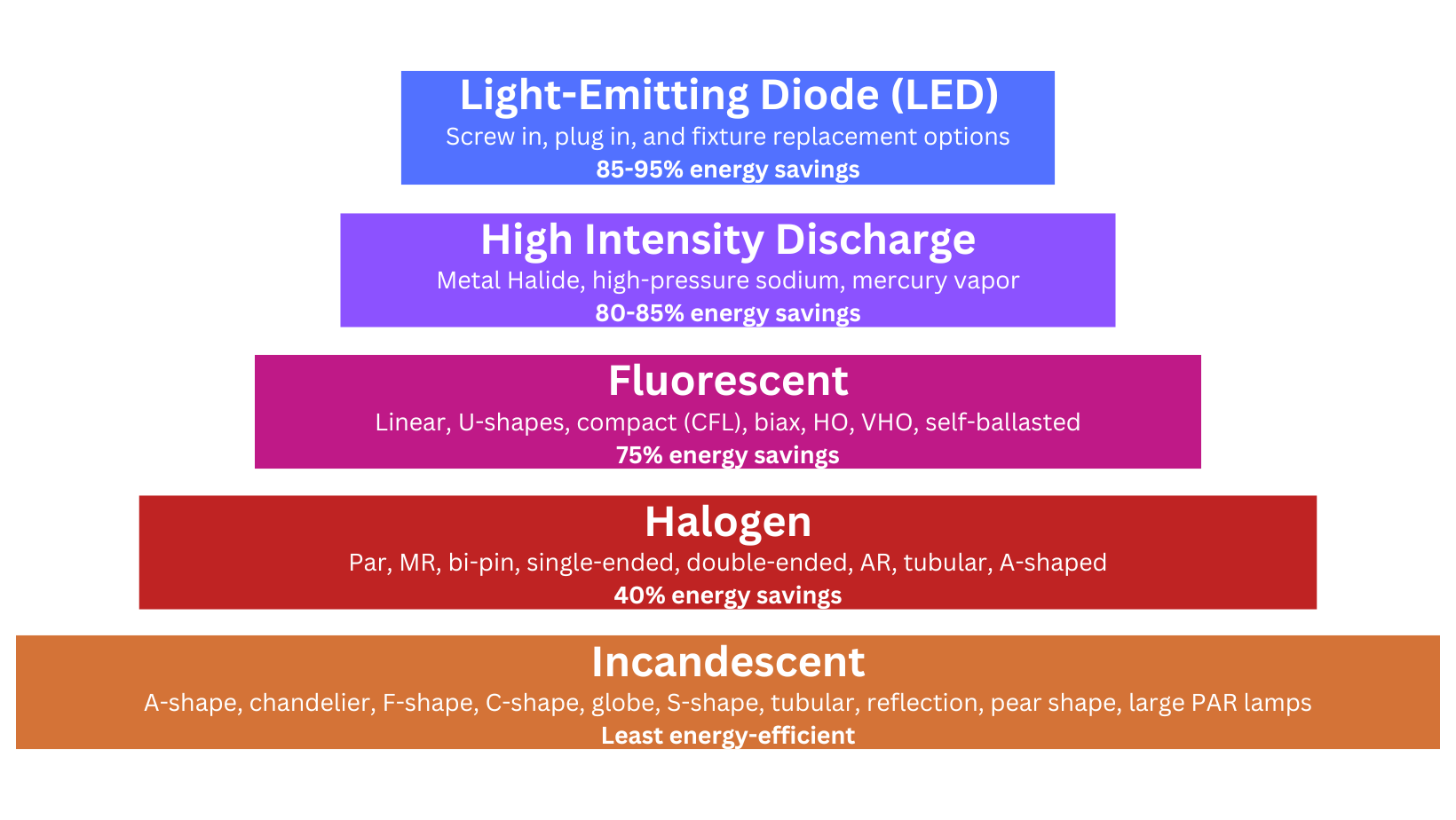Upgrading the lighting in your office can improve efficiency, performance and lead to major cost savings. When considering an upgrade, its always best to start with a lighting strategy to figure out what your lighting goals are, whether its lowering energy bills, improving sustainable measures, or optimizing it to create a more comfortable environment for employees. Continue reading to learn everything you need to know when considering an office LED upgrade!
Office LED Upgrade – What to Consider
Basic Lighting Standards
The minimum standard lighting for office buildings is determined by the U.S. General Services Administration (GSA). The administration recommends using 500 lumens per square meter.
For example, a standard desk lamp with a 60-watt bulb produces 800 lumens.
Other lighting standards provided by the GSA include,
- Using fluorescent fixtures and bulbs for ceiling lights. However, during your office lighting upgrade, we recommend replacing the bulbs and fixtures with energy-efficient LEDs due to the current bans on fluorescents.
- The lighting layout should evenly illuminate the space.
- Use task lighting options to fill in any gaps (dark areas).
- Minimize shadows by installing adjustable lighting options.
Type of Bulb
LED (light-emitting diode) bulbs are the best option to replace inefficient fluorescent, halogen, and incandescent lamps. Some of the advantages associated with an LED upgrade for office buildings are;
- LED bulbs are less expensive to operate and maintain
- LEDs have a longer lifespan
- LED fixtures use less electricity
- LED bulbs do not emit infrared radiation
- LEDs do not trigger migraines caused by bright light
- LEDs are adjustable to match the season and time of day
LEDs also do not interfere with melatonin production or disrupt your natural sleep pattern.

Temperature and Color
Temperature and color can impact an employee’s mood and productivity throughout the day. Having a cool white or blue toned lighting is best used for office spaces to promote alertness and concentration. As opposed to yellow toned lighting, which makes people feel more relaxed and comfortable. This can be used in the evenings when workers are leaving for the day.
Some LEDs are temperature and color adjustable, allowing you to mimic the natural light outside.
Brightness
Along with temperature and color, the light’s brightness also impacts energy levels throughout the day. Using brighter lights in the morning encourages alertness, creativity, and activity. A dimmer light in the afternoon is ideal for stationary tasks and work requiring focus. Other lighting control options, like daylighting, can automatically adjust the brightness of lights throughout the day. This allows for using natural sunlight during the afternoons and relying on LEDs during darker daylight hours.
Cost
A primary consideration during your office light upgrade is cost. LEDs are more expensive, but you can also take advantage of rebates and other financial incentives that make the upgrade more affordable. Light-emitting diodes can save you money in the long run. The bulbs use less energy, and last longer reducing maintenance costs. LEDs also emit less heat which produces additional savings.
LED Placement
Lighting can be strategically placed to create a more efficient workplace for employees. Different spaces require different lighting strategies, for example conference rooms will need lots of ambient lighting meanwhile individual workplaces can have ambient and task lighting. Deciding the placements of lighting options should be tailored to the office and employees’ needs.
It’s important not to create too many shadows or create glares on computer screens, and combine the types of lighting to make a well-lit environment.
There are major benefits to LEDs vs other lamps, but some people still assume that not all locations are right for LEDs. In our blog, Did You Know There is an LED for That? We review the many different types of LED and how you can find the perfect LED for any location.
Lighting Upgrade Checklist
1. Establish Your Project Guidelines
Lighting upgrades, like any other project, needs guidelines and a solid plan to keep it on track.
Some questions to answer include,
- What are your main project goals?
- What is your budget?
- Will you need to meet energy or building codes?
- Is one area in the building a higher priority than others?
Once you have a general guideline, you can fine-tune the minor details.
2. Look for High Burn Areas
High-burn areas should be the priority in a lighting project. These are the areas that have lights left on for numerous hours, such as parking areas and stairwells. From there you would move onto other common areas such as lobbies, workplaces, break rooms and restrooms. These areas typically only leave the lights on during the workday.
Your focus will probably be on replacing fluorescent bulbs with LEDs. We can help you find the best places to install linear LEDs in your commercial building. LEDs will work best, especially for high-burn areas because they have the longest lifespan on the market and provide the best performance.
3. Focus on Hard-to-Maintain Light Fixtures
After locating your high-burn areas, we recommend focusing on hard-to-maintain light fixtures.
These are the fixtures requiring special equipment to change out a bulb or are in areas that disrupt workflow. Focusing on these areas often improves safety and employee productivity, which should be included at the top of your list of lighting upgrade goals.
Not sure if concentrating on these areas is worth the expense? Consider the maintenance savings you will get with an LED lighting retrofit.
4. Consider Installing Lighting Controls
Lighting controls help conserve additional energy and lower your overall electrical bills. The controls are a good option in commercial buildings since most have spaces not always in use.
These areas can include meeting rooms, break rooms, bathrooms, and even offices where you do not need to leave the lights on all day. Some states are also requiring commercial businesses to use lighting controls to reduce energy consumption.
You can install simple or complex lighting controls. These can include scheduled lights, sensors, dimmers, daylighting and more. Some are even wireless, giving you more flexibility and allow them to be controlled at one central location. You do not need to rewire the building’s entire electrical system, and some even have smart technology. Using wireless signals, the controls can communicate with the system.
According to Phillips, you can save up to 55% more energy by using lighting controls.
Tips for Improving Office Lighting
Human Centric Lighting
Human centric lighting is a common strategy with a goal to make lighting healthy and comfortable for occupants. A poorly lit commercial office can lead to eyestrain and diminish the overall satisfaction of employees. Conversely, excessively bright lighting can cast harsh glares on computer screens, leading to headaches and distractions. Achieving the right blend involves utilizing natural light whenever possible and incorporating indirect ambient lighting and task lighting to ensure even illumination without glare or shadows.
Types of Lighting
The best office lighting is a fusion of various types of lighting to cater to the unique needs of the workspace. Here’s a breakdown of essential lighting elements:
Natural light: Offices can improve natural lighting through lots of windows and skylights. It has the most significant influence on employee mood, behavior, and satisfaction. It can even increase the real estate value of an office property by up to 20%.
Ambient lighting: Serves as the primary source of lighting to provide illumination of the entire room. This derives from ceiling and windows.
Task lighting: Additional lighting, such as desk lamps, placed at individual workstations. Task lighting complements ambient lighting by enhancing performance, reducing eyestrain, and alleviating workplace fatigue.
Corrective lighting: goes behind monitors, corrective lighting eases glare and ensures a comfortable viewing experience.
Accent lighting: Commonly known as mood lighting, accent lighting is primarily decorative and plays a lesser role in productivity for employees.
Selecting the appropriate light fixtures is crucial for achieving the desired lighting effect in an office setting. Indirect light fixtures, direct-indirect light fixtures, and shielded light fixtures offer unique benefits in terms of minimizing glare and providing even illumination.
- Indirect light fixtures project light upward to reflect off the ceiling and upper walls. These fixtures are effective in achieving the most even illumination with minimal direct glare.
- Direct-indirect light fixtures distribute light equally downward and upward. These fixtures strike a balance between providing task lighting and reducing glare.
- Shielded light fixtures use diffusers, lenses, and louvers to obstruct bulbs from direct view, and shield fixtures prevent glare and ensure even light distribution.
Benefits of Improving Office Lighting
- You can reduce overall operating costs. Incandescent and halogen bulbs produce a lot of heat. Switching to LEDs may give your HVAC system a break.
- LEDs have a long lifespan and are easier to replace than alternative lamps. This makes them easier to maintain in commercial facilities.
- Attract new clients with energy-saving LED lights. Clients are focusing more on sustainability. By switching to LEDs and lighting controls you can show you are concerned about the environment.
- Opting for LED lighting in the workplace brings numerous advantages. Although initially more expensive, LED lights prove cost-effective over time due to their extended lifespan, lower electricity consumption, reduced heat output, environmental benefits, and rebate recovery options.
Office LED Upgrades with Action Services Group
Action Services Group offers turn-key LED retrofit solutions for every industry and need. Solutions are tailored to accomplish your lighting goals and save time, money and resources. Our experts can walk you through the process of choosing the LED placement, fixtures, color and more! To speak with one of our specialists, call 610-558-9773, email [email protected], or schedule a call that fits your needs by clicking the button below.









































0 Comments